AHCCHM303 Prepare and apply chemicals
Added on 2023-04-21
34 Pages6714 Words196 Views
AHCCHM303
Prepare and apply chemicals
Assessment Guide
Questions assessed (please select) Orally - Written
Candidate Name:
Assessor Name:
Workplace/RTO:
Conditions:(e.g. On
or off the job)
I declare this is all Date:
my own work Student signature
Prepare and apply chemicals
Assessment Guide
Questions assessed (please select) Orally - Written
Candidate Name:
Assessor Name:
Workplace/RTO:
Conditions:(e.g. On
or off the job)
I declare this is all Date:
my own work Student signature
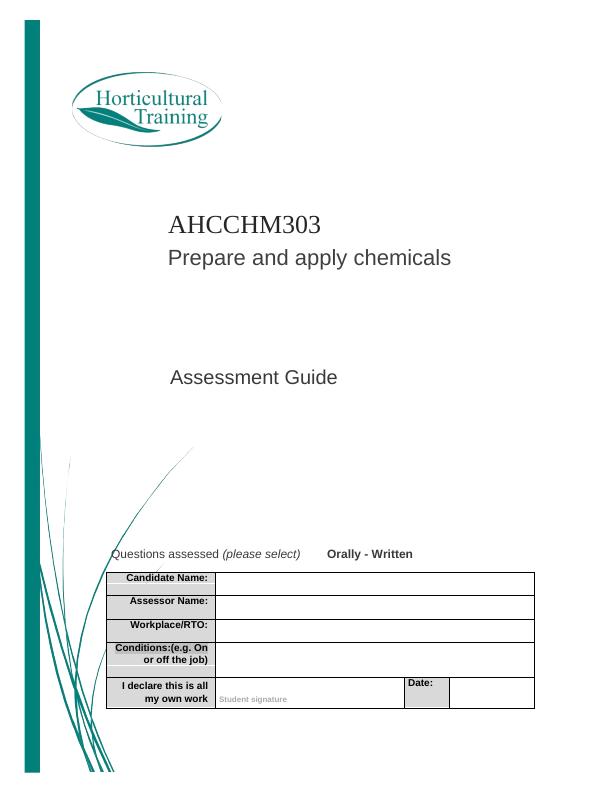
AHCCHM303 Prepare and apply chemicals
This work is copyright © Horticultural Training Pty Ltd 2016
All rights reserved. This work is copyright, but permission is given to students to make copies by
photocopying or other duplicating processes for personal use within their own workplace where
training is being conducted by Horticultural Training Pty Ltd. This permission does not extend to
the making of copies for use outside the immediate training environment for which they are
made, nor the making of copies for loan, hire or resale to third parties. For permission outside of
these guidelines, apply in writing to Horticultural Training Pty Ltd.
Written by: Shane White January 2017
Horticultural Training Pty Ltd
PO Box 134
Strathpine Queensland 4500
Telephone: 07 3264 8613
Web: www.horticulturaltraining.com.au
Email: admin@horticulturaltraining.com.au
Assessment Guide information
This Assessment Guide will assist you to build knowledge and skills towards a career in the
horticulture industry. It is a workbook that will be useful to you for recording your learning and for
presentation as evidence that you have completed the required learning and practice activities.
Where it fits
This Assessment Guide relates to the Unit of Competency AHCCHM303, level 3 for the horticultural
industry. AQF is the Australian Qualification Framework. Level 3 is for staff working unsupervised in the
workplace.
Recognition of current skills
If you can provide evidence that you already have the knowledge and skills covered in this Training
Guide, regardless of where they have been acquired, you can immediately apply for assessment.
Evidence may include reports, statements from training courses, references from previous
employers, photos, videos, practical demonstrations etc.
Assessment
The completed Assessment guide should be checked by your coach and trainer with your results then
recorded in your Competency Record Book. A Coach can be your employer, supervisor, trainer, teacher or
industry mentor. The Competency Record Book details your knowledge, skills and work performance.
Workplace health and safety
Any work in the horticulture sector may be dangerous in some way. It is important to know about
your work health and safety procedures. As an employee you have a responsibility to:
Follow your workplace’s work health and safety procedures
Follow manufacturers guidelines for machinery and equipment
Respond to a situation where someone is put at risk or injury (as long as you do not endanger
yourself)
Report any incidents or situations which cause you or other people injury, or put you or others
at risk.
Equipment and materials to help you complete activities in this guide you will need access to
the following:
Access to chemicals
A range of chemical application
equipment PPE
Labels and SDS
Safety procedures and a chemical application recording system
National Horticulture Competency Version 1
Horticultural Training Pty Ltd Jan 2017
P a g e | 2
This work is copyright © Horticultural Training Pty Ltd 2016
All rights reserved. This work is copyright, but permission is given to students to make copies by
photocopying or other duplicating processes for personal use within their own workplace where
training is being conducted by Horticultural Training Pty Ltd. This permission does not extend to
the making of copies for use outside the immediate training environment for which they are
made, nor the making of copies for loan, hire or resale to third parties. For permission outside of
these guidelines, apply in writing to Horticultural Training Pty Ltd.
Written by: Shane White January 2017
Horticultural Training Pty Ltd
PO Box 134
Strathpine Queensland 4500
Telephone: 07 3264 8613
Web: www.horticulturaltraining.com.au
Email: admin@horticulturaltraining.com.au
Assessment Guide information
This Assessment Guide will assist you to build knowledge and skills towards a career in the
horticulture industry. It is a workbook that will be useful to you for recording your learning and for
presentation as evidence that you have completed the required learning and practice activities.
Where it fits
This Assessment Guide relates to the Unit of Competency AHCCHM303, level 3 for the horticultural
industry. AQF is the Australian Qualification Framework. Level 3 is for staff working unsupervised in the
workplace.
Recognition of current skills
If you can provide evidence that you already have the knowledge and skills covered in this Training
Guide, regardless of where they have been acquired, you can immediately apply for assessment.
Evidence may include reports, statements from training courses, references from previous
employers, photos, videos, practical demonstrations etc.
Assessment
The completed Assessment guide should be checked by your coach and trainer with your results then
recorded in your Competency Record Book. A Coach can be your employer, supervisor, trainer, teacher or
industry mentor. The Competency Record Book details your knowledge, skills and work performance.
Workplace health and safety
Any work in the horticulture sector may be dangerous in some way. It is important to know about
your work health and safety procedures. As an employee you have a responsibility to:
Follow your workplace’s work health and safety procedures
Follow manufacturers guidelines for machinery and equipment
Respond to a situation where someone is put at risk or injury (as long as you do not endanger
yourself)
Report any incidents or situations which cause you or other people injury, or put you or others
at risk.
Equipment and materials to help you complete activities in this guide you will need access to
the following:
Access to chemicals
A range of chemical application
equipment PPE
Labels and SDS
Safety procedures and a chemical application recording system
National Horticulture Competency Version 1
Horticultural Training Pty Ltd Jan 2017
P a g e | 2
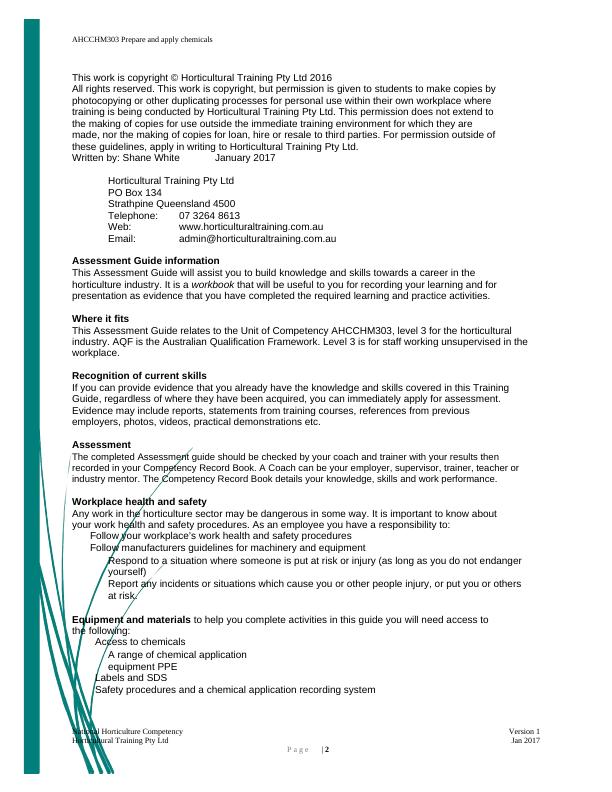
AHCCHM303 Prepare and apply chemicals
Assessments Task No 1 Product label/SDS reading and interpretation
When using agrochemicals in the workplace having the ability to understand and interpret the labels and SDS are
necessary to ensure safe and correct application can occur. To answer the following questions please read the
accompanying Chemical Label and Safety data sheet (SDS).
Question No 1
What is the trade name of this product?
AMBUSH® EC Insecticide
.....................................................................................................................
Performance Criteria ( 3.1, KA3 )
Question No 2
What is/are the active constituent/s for this product?
500 g/L PERMETHRIN
.....................................................................................................................
Performance Criteria ( 3.1, KA3 )
Question No 3
Who is the manufacturer?
Agnova technologies ltd
.....................................................................................................................
Performance Criteria ( 3.1, KA3 )
Question No 4
What is the hazard rating for this product?
Danger
.....................................................................................................................
Performance Criteria ( 3.1, KA3 )
Question No 5
What group of pests is this pesticide registered to control? (Please circle the correct answer.)
Weeds
Diseases
(Insects)
Mites
Performance Criteria ( 1.1, CA2)
Question No 6
Is this product a dangerous good? Yes/No. If so, what category does it belong to? (Please circle the correct answer)
Flammable liquid Class 3
Oxidizing agent Class 5
(Toxic substance) Class 6
Corrosive substance Class 8
(Environmentally hazardous substance) Class 9. Performance Criteria ( )
Question No 7
What is the first aid procedure where the product may have accidentally splashed on skin?
Will irritate the skin. Avoid contact with skin. If skin contact occurs remove contaminated clothing and wash
affected areas thoroughly with soap and water. Wash contaminated clothing before reuse. If swelling, redness,
blistering or irritation occurs, seek medical advice.
..............................................................................................................................
Performance Criteria ( 3.2 )
Question No 8
What is the Acute Oral LD50 for this product?
LD50 = 806 mg/kg (male); 814 mg/kg (female)
...............................................................................................................................
Performance Criteria ( 3.1)
National Horticulture Competency Version 1
Horticultural Training Pty Ltd Jan 2017
P a g e | 3
Assessments Task No 1 Product label/SDS reading and interpretation
When using agrochemicals in the workplace having the ability to understand and interpret the labels and SDS are
necessary to ensure safe and correct application can occur. To answer the following questions please read the
accompanying Chemical Label and Safety data sheet (SDS).
Question No 1
What is the trade name of this product?
AMBUSH® EC Insecticide
.....................................................................................................................
Performance Criteria ( 3.1, KA3 )
Question No 2
What is/are the active constituent/s for this product?
500 g/L PERMETHRIN
.....................................................................................................................
Performance Criteria ( 3.1, KA3 )
Question No 3
Who is the manufacturer?
Agnova technologies ltd
.....................................................................................................................
Performance Criteria ( 3.1, KA3 )
Question No 4
What is the hazard rating for this product?
Danger
.....................................................................................................................
Performance Criteria ( 3.1, KA3 )
Question No 5
What group of pests is this pesticide registered to control? (Please circle the correct answer.)
Weeds
Diseases
(Insects)
Mites
Performance Criteria ( 1.1, CA2)
Question No 6
Is this product a dangerous good? Yes/No. If so, what category does it belong to? (Please circle the correct answer)
Flammable liquid Class 3
Oxidizing agent Class 5
(Toxic substance) Class 6
Corrosive substance Class 8
(Environmentally hazardous substance) Class 9. Performance Criteria ( )
Question No 7
What is the first aid procedure where the product may have accidentally splashed on skin?
Will irritate the skin. Avoid contact with skin. If skin contact occurs remove contaminated clothing and wash
affected areas thoroughly with soap and water. Wash contaminated clothing before reuse. If swelling, redness,
blistering or irritation occurs, seek medical advice.
..............................................................................................................................
Performance Criteria ( 3.2 )
Question No 8
What is the Acute Oral LD50 for this product?
LD50 = 806 mg/kg (male); 814 mg/kg (female)
...............................................................................................................................
Performance Criteria ( 3.1)
National Horticulture Competency Version 1
Horticultural Training Pty Ltd Jan 2017
P a g e | 3
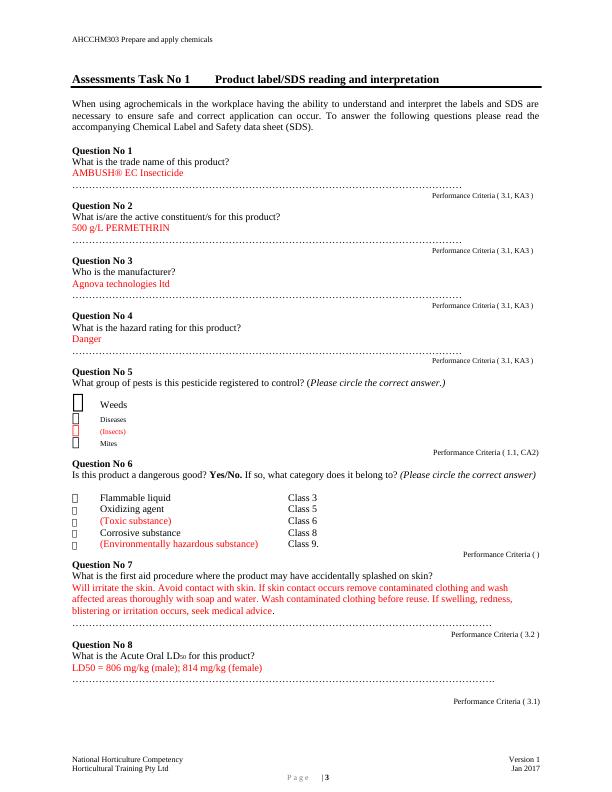
AHCCHM303 Prepare and apply chemicals
Assessment Task No 2 The following questions are multiple choice. Circle the correct answer.
(Please note: there is only one correct answer for each).
Question No 1
What is the main objective of Integrated Pest Management?
a) To use pesticides
b) To use biological controls
c) To eradicate pests*
d) To manage pests Performance Criteria (1.3)
Question No 2
Of the following application methods which has the ability to produce a uniform droplet size if used correctly?
a) Wick wiper
b) Hydraulic
c) Controlled droplet application*
d) Granule Performance Criteria (2.2, KA8)
Question No 3
Which one of the following nozzles is best suited for the application of herbicides in a drift sensitive area?
a) Solid cone nozzle
b) Hollow cone nozzle
c) Flat fan nozzle*
d) Coarse or very coarse flat fan nozzle Performance Criteria (2.2, KA8)
Question No 4
What are the optimum spraying conditions when using pesticides?
a) Low wind in hot dry conditions
b) Slight breeze in cool conditions
c) Still air in hot conditions
d) High wind in cool conditions Performance Criteria (2.4, KA4)
Question No 5
In the event of a spillage of pesticide concentrates, as a clean up procedure what would you do first?
a) Hose the chemical down to dilute it
b) Wear PPE and keep others away
c) Try to collect as much spill as possible with the bailing technique
d) Clean affected area with detergent and a small amount of water. Performance Criteria (3.6)
Question No 6
Respirators that incorporate activated carbon filters should be cleaned after use and then?
a) Placed in the rubber boots you also use while handling pesticides?
b) Stored in a clean, sealed plastic bag or air-tight container and placed in a cupboard/locker?
c) Stored in the glove box of the work truck?
d) Hung on their special hook in the chemical store? Performance Criteria (4.4)
Question No 7
Horticultural pesticides are often applied as a liquid droplet. There are three (3) basic ways of creating these droplets
in the field. These are:
a) Controlled droplet applicator, wick wiper, hydraulic pressure
b) Wick wiper, controlled droplet applicator, airshear
c) Hydraulic pressure, controlled droplet applicator, airshear
d) Airshear, wick wiper, hydraulic pressure Performance Criteria (KA8)
National Horticulture Competency Version 1
Horticultural Training Pty Ltd Jan 2017
P a g e | 4
Assessment Task No 2 The following questions are multiple choice. Circle the correct answer.
(Please note: there is only one correct answer for each).
Question No 1
What is the main objective of Integrated Pest Management?
a) To use pesticides
b) To use biological controls
c) To eradicate pests*
d) To manage pests Performance Criteria (1.3)
Question No 2
Of the following application methods which has the ability to produce a uniform droplet size if used correctly?
a) Wick wiper
b) Hydraulic
c) Controlled droplet application*
d) Granule Performance Criteria (2.2, KA8)
Question No 3
Which one of the following nozzles is best suited for the application of herbicides in a drift sensitive area?
a) Solid cone nozzle
b) Hollow cone nozzle
c) Flat fan nozzle*
d) Coarse or very coarse flat fan nozzle Performance Criteria (2.2, KA8)
Question No 4
What are the optimum spraying conditions when using pesticides?
a) Low wind in hot dry conditions
b) Slight breeze in cool conditions
c) Still air in hot conditions
d) High wind in cool conditions Performance Criteria (2.4, KA4)
Question No 5
In the event of a spillage of pesticide concentrates, as a clean up procedure what would you do first?
a) Hose the chemical down to dilute it
b) Wear PPE and keep others away
c) Try to collect as much spill as possible with the bailing technique
d) Clean affected area with detergent and a small amount of water. Performance Criteria (3.6)
Question No 6
Respirators that incorporate activated carbon filters should be cleaned after use and then?
a) Placed in the rubber boots you also use while handling pesticides?
b) Stored in a clean, sealed plastic bag or air-tight container and placed in a cupboard/locker?
c) Stored in the glove box of the work truck?
d) Hung on their special hook in the chemical store? Performance Criteria (4.4)
Question No 7
Horticultural pesticides are often applied as a liquid droplet. There are three (3) basic ways of creating these droplets
in the field. These are:
a) Controlled droplet applicator, wick wiper, hydraulic pressure
b) Wick wiper, controlled droplet applicator, airshear
c) Hydraulic pressure, controlled droplet applicator, airshear
d) Airshear, wick wiper, hydraulic pressure Performance Criteria (KA8)
National Horticulture Competency Version 1
Horticultural Training Pty Ltd Jan 2017
P a g e | 4
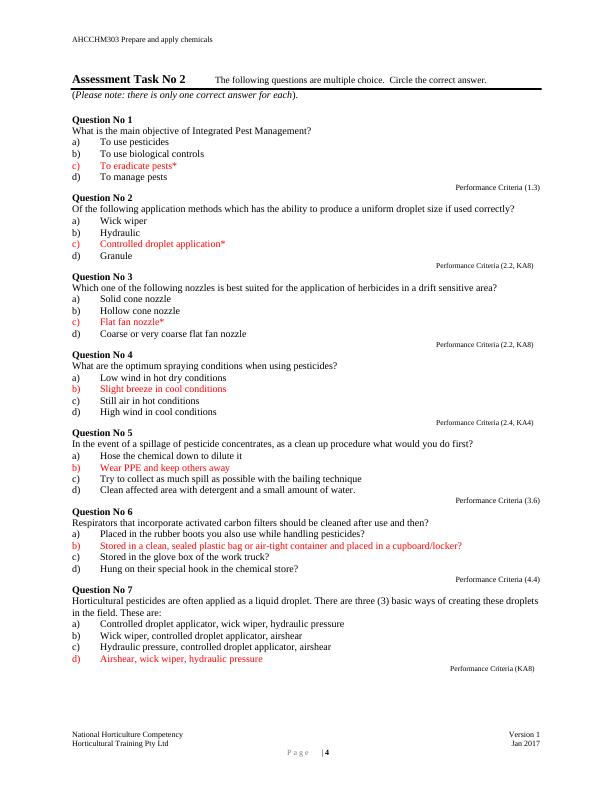
AHCCHM303 Prepare and apply chemicals
Question No 8
How would you clean a blocked nozzle?
a) Use a thin wire.
b) Use a soft brush and clean water
c) Blow through it with your mouth
d) Use a steel brush and clean water. Performance Criteria (4.1, KA8)
Question No 9
A knapsack sprayer forms droplets using:
a) Aerosol
b) Hydraulic pressure
c) Air shear
d) Spinning disc Performance Criteria (4.1, KA8)
Question No 10
A spray boom fitted with 12 nozzles at a spacing of 0.5m would have a swath width of:
a) 5m
b) 6m
c) 7m
d) 12m Performance Criteria (4.1, KA8)
Question No 11
Which LD50 rating is potentially the most hazardous?
a) Acute (Oral) LD50 230-300 mg/kg rat
b) Acute (Oral) LD50 5-10 mg/kg rat
c) Acute (Oral) LD50>5000 mg/kg rat
d) Acute (Oral) LD50 500-700 mg/kg rat Performance Criteria (3.1)
Question No 12
Where should you keep your SDS?
a) On outside of the chemical store
b) At home
c) Office
d) a and c Performance Criteria (3.2, KA7)
Question No 13
What are the correct steps for the removal of a splash of diluted pesticide on your skin?
a) Wipe area clean with a rag
b) Wash area with hot water
c) Wash at next break
d) Wash with plenty of water and check SDS Performance Criteria (4.5)
Question No 14
Which control method should be considered when developing an integrated pest management plan?
a) Quarantine
b) Chemical
c) Biological
d) a, b and c
e) b and c Performance Criteria (1.3)
National Horticulture Competency Version 1
Horticultural Training Pty Ltd Jan 2017
P a g e | 5
Question No 8
How would you clean a blocked nozzle?
a) Use a thin wire.
b) Use a soft brush and clean water
c) Blow through it with your mouth
d) Use a steel brush and clean water. Performance Criteria (4.1, KA8)
Question No 9
A knapsack sprayer forms droplets using:
a) Aerosol
b) Hydraulic pressure
c) Air shear
d) Spinning disc Performance Criteria (4.1, KA8)
Question No 10
A spray boom fitted with 12 nozzles at a spacing of 0.5m would have a swath width of:
a) 5m
b) 6m
c) 7m
d) 12m Performance Criteria (4.1, KA8)
Question No 11
Which LD50 rating is potentially the most hazardous?
a) Acute (Oral) LD50 230-300 mg/kg rat
b) Acute (Oral) LD50 5-10 mg/kg rat
c) Acute (Oral) LD50>5000 mg/kg rat
d) Acute (Oral) LD50 500-700 mg/kg rat Performance Criteria (3.1)
Question No 12
Where should you keep your SDS?
a) On outside of the chemical store
b) At home
c) Office
d) a and c Performance Criteria (3.2, KA7)
Question No 13
What are the correct steps for the removal of a splash of diluted pesticide on your skin?
a) Wipe area clean with a rag
b) Wash area with hot water
c) Wash at next break
d) Wash with plenty of water and check SDS Performance Criteria (4.5)
Question No 14
Which control method should be considered when developing an integrated pest management plan?
a) Quarantine
b) Chemical
c) Biological
d) a, b and c
e) b and c Performance Criteria (1.3)
National Horticulture Competency Version 1
Horticultural Training Pty Ltd Jan 2017
P a g e | 5

AHCCHM303 Prepare and apply chemicals
Assessment Task No 3 The following statements refer to the use of pesticides.
(Please circle true or false)
1. IPM replaces pesticides in pest management? TRUE FALSE
2. Pests should be sprayed as soon as they appear and start to cause damage TRUE FALSE
to the crop.
3. The use of pesticides is considered a part of IPM. TRUE FALSE
4. The grower and/or consultant are important stake holders in IPM. TRUE FALSE
5. For resistance management, rotate between sprays of different chemical TRUE FALSE
groups.
6. If a particular spray doesn’t work a repeat spray of the same product TRUE FALSE
should be used as soon as possible.
7. More detailed medical advice on treating a poisoned victim can be found TRUE FALSE
on a safety data sheet (SDS).
8. Chemical management aims to eradicate pests TRUE FALSE
9. A wick wiper can be used for controlled fruit fly TRUE FALSE
10. A boom spray fitted with hollow cone nozzles is used to control broad leaf TRUE FALSE
weeds in turf.
11. Quarantine measures should be considered in an integrated pest TRUE FALSE
management plan.
Performance Criteria (1.1, 1.3, 3.1, 3.5)
National Horticulture Competency Version 1
Horticultural Training Pty Ltd Jan 2017
P a g e | 6
Assessment Task No 3 The following statements refer to the use of pesticides.
(Please circle true or false)
1. IPM replaces pesticides in pest management? TRUE FALSE
2. Pests should be sprayed as soon as they appear and start to cause damage TRUE FALSE
to the crop.
3. The use of pesticides is considered a part of IPM. TRUE FALSE
4. The grower and/or consultant are important stake holders in IPM. TRUE FALSE
5. For resistance management, rotate between sprays of different chemical TRUE FALSE
groups.
6. If a particular spray doesn’t work a repeat spray of the same product TRUE FALSE
should be used as soon as possible.
7. More detailed medical advice on treating a poisoned victim can be found TRUE FALSE
on a safety data sheet (SDS).
8. Chemical management aims to eradicate pests TRUE FALSE
9. A wick wiper can be used for controlled fruit fly TRUE FALSE
10. A boom spray fitted with hollow cone nozzles is used to control broad leaf TRUE FALSE
weeds in turf.
11. Quarantine measures should be considered in an integrated pest TRUE FALSE
management plan.
Performance Criteria (1.1, 1.3, 3.1, 3.5)
National Horticulture Competency Version 1
Horticultural Training Pty Ltd Jan 2017
P a g e | 6
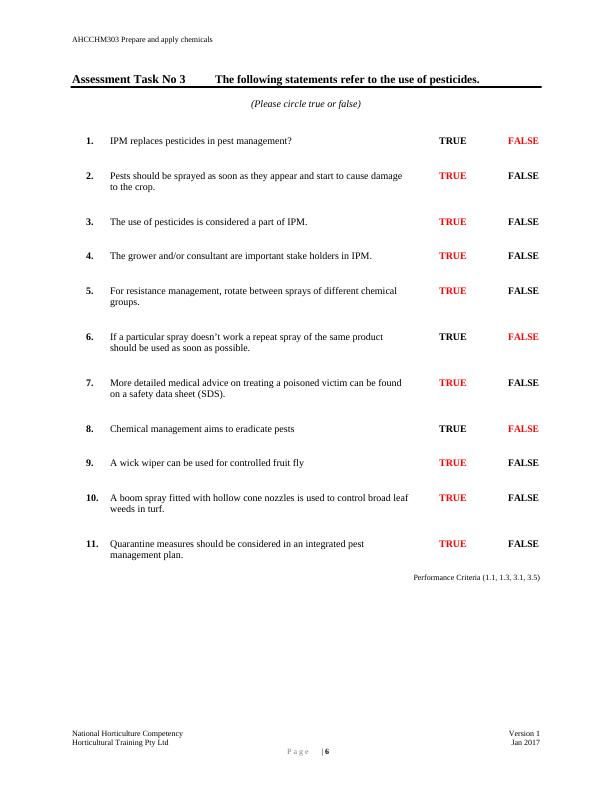
AHCCHM303 Prepare and apply chemicals
Assessment Task No 4 Short Answer Questions
Question No 1
What is a safety data sheet (SDS), where can you obtain them and why are they required?
A document that have all information into relation with safety and health occupation for the use of various products.
Obtain SDS Can from the companies that produce the products.
They are important because they provide information on how to use the products and how to handle the products
Performance Criteria (3.1,KA3)
Question No 2
How do you identify registered dangerous goods?
Dangerous registered goods are found in the UTZs and SAN information according to the certification procedure
Performance Criteria (6.6)
Question No 3
What is calibration and why is it necessary?
This is the act of rectifying measurement of the output of a substance as according to the set standards.
.......................................................................................
Calibration is necessary as it allows the traceability of the measurement and allows accuracy of the instrument
...........................................................................................................................................
Performance Criteria (4.2, 4.3, CA5, KA6)
Question No 4
Name and describe the two forms of poisoning that a person mixing chemicals can suffer from?
Inhaled. This can happen when mixing powdery chemicals like super Nordic
Eye contact. This might happen when the chemicals splat into the eyes causing irritation and can lead to blindness if
not attended immediately
Performance Criteria (5.3)
Question No 5
Explain what the term LD 50 refers to?
LD refers to lethal dose.
This is the percentage of certain animals died after an injection done during test of a certain chemicals
Performance Criteria (5.1)
Question No 6
Name the five (5) ways a pesticide can enter your body?
1) Inhalation........................................................................
2) Orally........................................................................
3) Dermally .....................................................................
4) Ingestion......................................................................
5) ..........................................................................
Performance Criteria (1.4, KA 7)
Question No 7
What are the three (3) fastest routes for a chemical to enter your body via the skin?
1) Eye......................................................................
2) Contact ...................................................................
3) Mouth surface without ingestion.................................................................
Performance Criteria (1.4, KA7)
Assessment Task No 4 Short Answer Questions
Question No 1
What is a safety data sheet (SDS), where can you obtain them and why are they required?
A document that have all information into relation with safety and health occupation for the use of various products.
Obtain SDS Can from the companies that produce the products.
They are important because they provide information on how to use the products and how to handle the products
Performance Criteria (3.1,KA3)
Question No 2
How do you identify registered dangerous goods?
Dangerous registered goods are found in the UTZs and SAN information according to the certification procedure
Performance Criteria (6.6)
Question No 3
What is calibration and why is it necessary?
This is the act of rectifying measurement of the output of a substance as according to the set standards.
.......................................................................................
Calibration is necessary as it allows the traceability of the measurement and allows accuracy of the instrument
...........................................................................................................................................
Performance Criteria (4.2, 4.3, CA5, KA6)
Question No 4
Name and describe the two forms of poisoning that a person mixing chemicals can suffer from?
Inhaled. This can happen when mixing powdery chemicals like super Nordic
Eye contact. This might happen when the chemicals splat into the eyes causing irritation and can lead to blindness if
not attended immediately
Performance Criteria (5.3)
Question No 5
Explain what the term LD 50 refers to?
LD refers to lethal dose.
This is the percentage of certain animals died after an injection done during test of a certain chemicals
Performance Criteria (5.1)
Question No 6
Name the five (5) ways a pesticide can enter your body?
1) Inhalation........................................................................
2) Orally........................................................................
3) Dermally .....................................................................
4) Ingestion......................................................................
5) ..........................................................................
Performance Criteria (1.4, KA 7)
Question No 7
What are the three (3) fastest routes for a chemical to enter your body via the skin?
1) Eye......................................................................
2) Contact ...................................................................
3) Mouth surface without ingestion.................................................................
Performance Criteria (1.4, KA7)
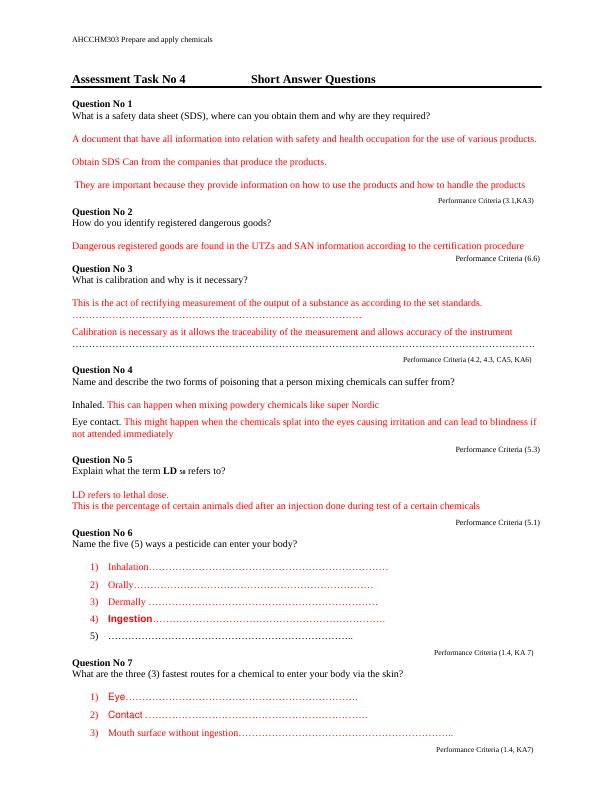
National Horticulture Competency
Horticultural Training Pty Ltd
Version 1
Jan 2017
P a g e | 7
Horticultural Training Pty Ltd
Version 1
Jan 2017
P a g e | 7

End of preview
Want to access all the pages? Upload your documents or become a member.
Related Documents
Transport and store chemicalslg...
|31
|6396
|264
Control Weeds - Assessment Guidelg...
|34
|8767
|361
HLTWHS002 Follow Safe Work Practices for Direct Client Care Assessment Workbooklg...
|38
|5637
|232
Developing workplace communication strategies Participant Workbook CHCCOM003 PW Moodle CHC51015 V1.0 CHCCOM003 Develop workplace communication strategies Participant Workbook CHCCOM003 PW Moodle CHC51lg...
|76
|11192
|92
Designing and Implementing Service Programslg...
|12
|2115
|12
Designing and Implementing Service Programs - Significancelg...
|12
|2691
|15
